Gypsy Queens: A journey into the heart of Spain to discover flamenco
In southern Spain, flamenco is not just a form of music, but a form of life itself
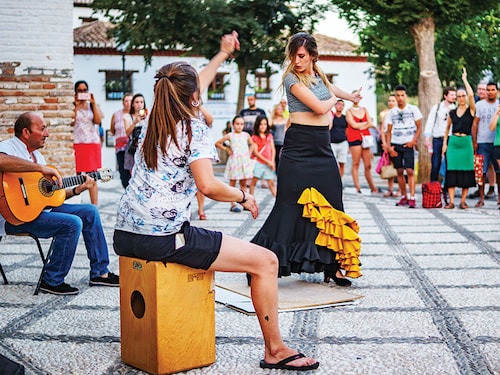

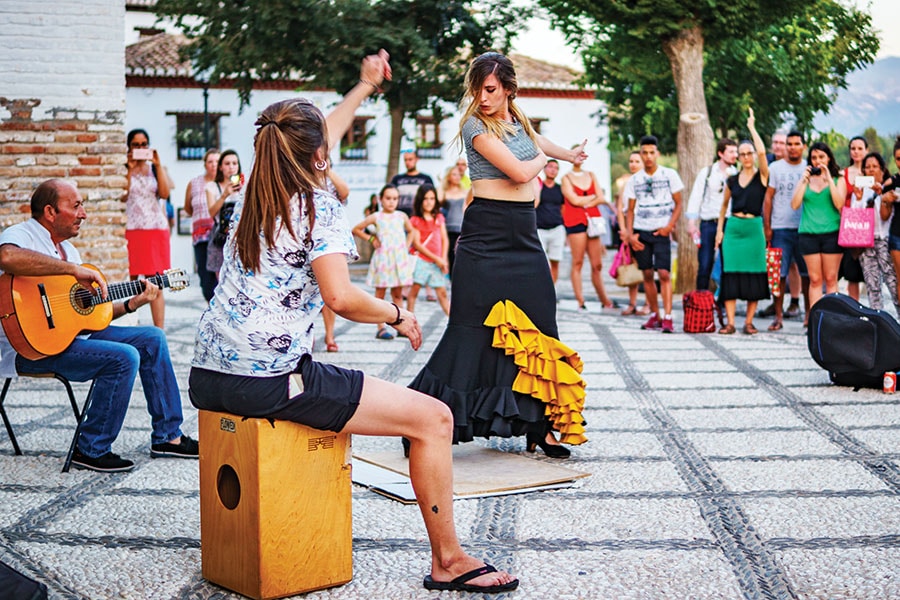 A flamenco dancer performs before tourists at San Nicolas viewpoint in Granada, Spain
A flamenco dancer performs before tourists at San Nicolas viewpoint in Granada, Spain
Image: Shutterstock
“This is a wild goose chase!” whined my friend, even as Google maps claimed, “You’ve arrived”. It was almost midnight by the time we crossed on foot the Puente de Triana, the 19th-century bridge that connects Seville with the historic neighbourhood of Triana. Searching for Casa Anselma, we made our way through Triana, half expecting to come across a dimly lit tavern with posters proclaiming ‘Flamenco’ at any moment. Instead, we struggled to find a sign that marked Casa Anselma itself, let alone the flamenco. A small crowd of middle-aged to elderly men and women ambled around and looked uneasily at us three young men, non-Spanish, yet not guiri (Europeans). They all were waiting for something, although no one seemed sure what.
The internet had warned of this. Whether Casa Anselma would host a flamenco night or not totally depended on Ms Anselma’s whims and fancies. Then, suddenly, a murmur rose from the crowd. Everyone looked towards a yellow wall, which shuddered as a shutter within it was pulled up, and then, as dim lights were lit inside, men and women swarmed their way into Casa Anselma. The walls of the casa bore a strong vintage tan, decked with fair posters. A woman, possibly in her sixties, Ms Anselma, stood right up ahead in the hall, guiding everyone to their chairs.
Slowly, the musical ensemble in front was taking shape. A man marched in to sit on a cajon—a box-shaped percussion instrument—while two guitarists joined him on either side. To their far right sat Anselma, regaling people with accounts from her past as a flamenco dancer. The audience gasped, and then let out roaring laughter. “I think she’s just lying,” said an Argentinian woman sitting beside me.
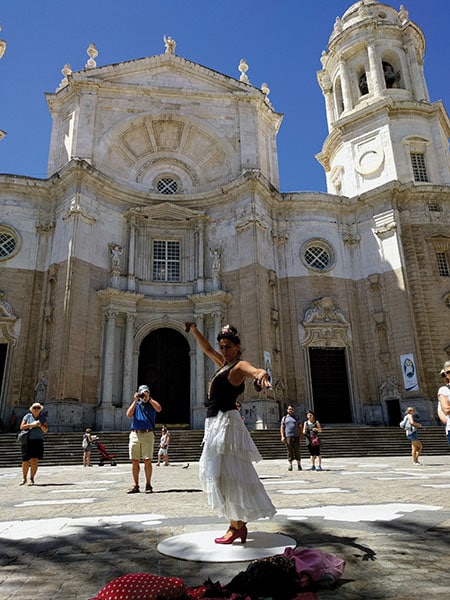
Cadiz is one of the biggest contributors to flamenco’s rich past
Photographs: Harsh Mehta
In due time, I hear palmas—the gypsy art of clapping in sync with the flamenco rhythm—accompanied by the deep voice of Anselma, while music flows from the guitars. The rest of the men in the band join in with their rustic voices, as does the audience. ‘Te Quiero Sevilla’ (I love you Seville), they all sing. Women from the audience twirl and swerve as they join Anselma in dancing. Slowly, the entire room is high on the flamenco’s beats. A woman in the audience is overcome by the mood and rushes to kiss Anselma on her cheek. By 2.30 am, when the merry making comes to an end, everyone is in a cheery daze of sorts. Few, if any, want to leave. But at Casa Anselma you leave, as you arrive—by the will of Anselma, who decides when the performance will come to an end.
Flamenco hasn’t always enjoyed the position in the Spanish arts as it does now. In a country as diverse as Spain, multiple dance and music forms have dominated different regions at different times. The Jota from Aragon, Sardana from Catalonia, Bolero from Galicia have all influenced Spain’s dance traditions. During the period of Francisco Franco’s dictatorship (1939-1975) following the Spanish Civil war, several of these minority art forms faced oppression. In his intriguing book The Flamencos of Cadiz Bay, about learning flamenco guitar in the 1950s in Spain, Gerald Howson, writes how he had to land up in Spain in the garb of being an English teacher and how acquaintances in the Galician (north-west Spain) countryside would treat his attempt to learn flamenco guitar with contempt, for it represented “all that was most backward” in the country. Howson mentions listening to everything—20 varieties of Asturianas from the region of Asturia, and songs from Salamanca, both in the north-west of Spain—but flamenco.
While the details could vary, flamenco originated in the streets and homes of the gypsies of southern Spain, Andalusia, possibly around the 16th century. For long, in this part of Spain, it has been a form of expression and celebration during street fiestas and family gatherings. It was only during the end of the 1950s that flamenco was used by Franco as a symbol of Spanish national identity.
Seville, being the largest Andalusian city, took in the largest share of tourists’ sightings of the dance. Over time, Madrid and Barcelona developed their own professional flamenco performance centres, most of which had formal stages and dance settings for the audience. However, it’s the smaller towns that seem to truly embody the spirit of this art form.
Tony Bryant, in Flamenco, An Englishman’s Passion, writes about Anselma being one of the last few people keeping the spirit of flamenco alive in Triana. He goes on to mention the importance of three cities in the development of flamenco in Spain—Triana, Jerez and Cadiz. The most significant forms of flamenco dancing and singing, known as Cante Jondo (pronounced ‘hondo’) evolved in these cities. What we witnessed at Casa Anselma would probably be described as Sevillana, a form, which, depending on what you refer to, could be termed a variant of flamenco or a separate folk dance in itself.
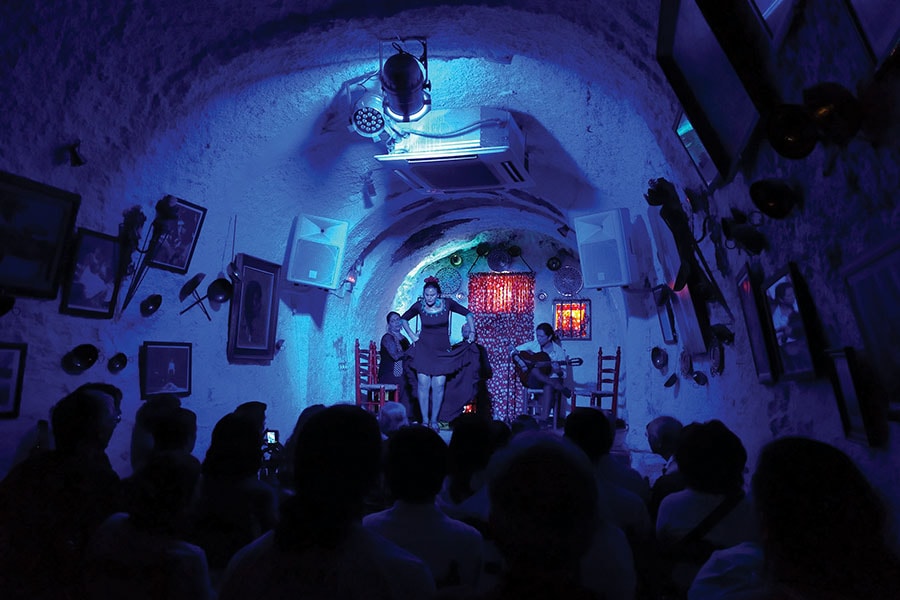 Granada is known to showcase the unadulterated form of the dance with dancers performing in caves with neon lights
Granada is known to showcase the unadulterated form of the dance with dancers performing in caves with neon lights
A short drive further south from Triana lies the island of Cadiz. As you cross the bridge from the Spanish mainland, it seems like travelling back a few centuries in time. Photographers won’t need a sepia filter here. Everything—including its long winding beach line, the faded old houses that line its promenades, and the 180-year-old cathedral in the town square—seem to have developed a sun-kissed tan over all the years spent at the frontiers of this Costa De la Luz, the coast of light.
The Plaza de la Catedral of Cadiz stands testimony to flamenco. In summer, as the sun beats down on its white-and-brown stone walls, a woman in white and black attire walks into the heart of the square and lays down her stock of dance clothes: A piece of red clothing with white polka dots, a black one with multi-coloured embroidery, a purple scarf beside them. Together, they constitute what’s called the Traje de Gitana (the flamenco outfit of gypsy women). She ties a large bead to each of her thumbs, and breaks into an impromptu flamenco performance. Throwing her hands high up in the air, she swerves and rotates and clatters her red heels over a round wooden board, all this while needing no singing to accompany her—she’s the dance, she’s the lyrics and she, the music.
A little further, at the Plaza de San Juan de Dios, a group of children has gathered around a woman in black and red. She is accompanied by a guitarist, a singer and another woman bailaora (dancer). Behind them lay a small blackboard, thanking people for their donations. More interestingly, it listed certain key forms of flamenco—buleria de Jerez, tangos seguirilla, Alegrias, Sevillanas, Soleá, Buleria and Tientos Tangos.
Among its variations mentioned, Alegrias and Tientos evolved in Cadiz, home to artists such as Enrique el Mellizo, who refused to sing professionally and yet is considered one of the most influential flamenco singers in history.
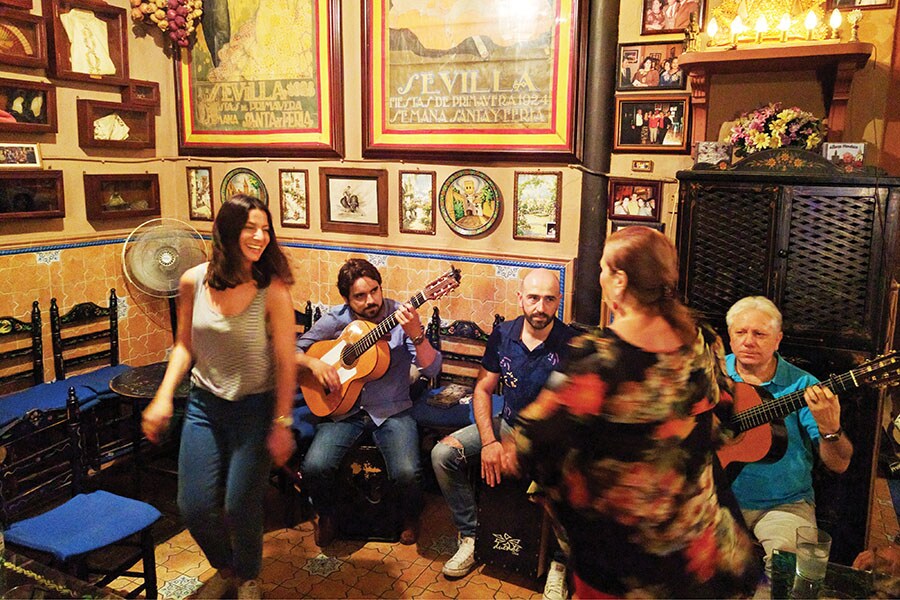 People have kept the spirit of flamenco alive in Triana
People have kept the spirit of flamenco alive in Triana
If Cadiz excelled at free-flowing flamenco, it was the town of Granada that took us by surprise with an absolutely raw, unadulterated form of the dance. Every evening in the hills of Granada, the whitewashed walls of a tablao (a stage for flamenco performances) on the Camino Del Sacromonte come alive with colours and emotions of the gypsies. The flamenco that developed here, called Zambra, is faster in pace. Typically performed as pre-wedding songs and dances in Andalusia, Zambra is folkloric and is performed in three stages, each representing a different stage of a gypsy wedding.
At one such tablao, innocuous neon lights proclaiming the name ‘Cuevas Los Tarantos’ lead to a cave with a modest stage in front and a seating capacity of 30. The performance here turns into one with all the typical elements: Deep cante, rhythmic palmas, fast-paced foot tapping, sensual guitar strumming. A bailaora stands and grabs her ruffled skirt in both hands and bursts into percussive footwork, as fellow dancers sit beside her and chant ‘Ole, Ole!’. At times, I see a glimpse of the much talked about state of ‘duende’, a spirited stage in flamenco dancing that evokes strong emotions.
Granada reserves this for those who are curious enough to wade through the medieval lanes of Sacromonte, the neighbourhood where gypsies have thrived in cave dwellings for centuries.
Like Romani communities in other parts of Europe, Andalusian gypsies too have lived in dire or marginalised conditions. For several years, they were either persecuted or ignored or suffered plain discrimination. Literacy and employment rates and living conditions remained rather poor. Perhaps, the gypsies melded their hopes and despair in the deep cante and the confounding jaleo of flamenco. And it is this pathos that comes to the fore when you watch them perform.
In folklore, the gypsies trace their origins to Rajasthan, from where they migrated westwards centuries ago. The hand movements, twirling skirts, rhythms and melancholy of flamenco are reminiscent of Rajasthani nomadic music. Had I just unravelled a distant memory of India in the lanes of Andalusia? I’m still wondering.
First Published: May 26, 2018, 07:32
Subscribe Now